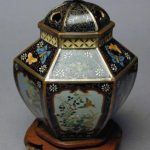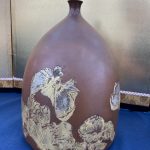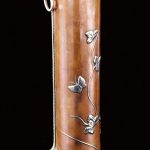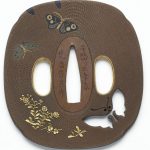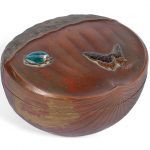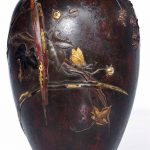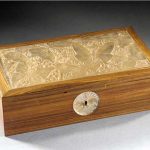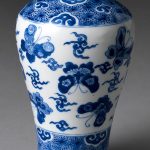Copper Butterflies. Copper is one of the few metals that can occur in nature in a directly usable metallic form (native metals). This led to very early human use in several regions, from c. 8000 BC. Thousands of years later, it was the first metal to be smelted from sulfide ores, c. 5000 BC, the first metal to be cast into a shape in a mold, c. 4000 BC and the first metal to be purposefully alloyed with another metal, tin, to create bronze, c. 3500 BC. Reference: Wikipedia
Below are some examples of antique copper objects decorated, or in the form of, butterflies including a Tiffany & Co silver mounted copper vase and an enamel and copper chestnut box.
Silvered-Copper Mounted Hexagonal Cloisonne Covered Vase Meiji Period, Adachi (?) stamp Five panels are decorated within a shaped r Meiji Period, Adachi (?) stamp Five panels are decorated within a shaped reserve with birds and flowers, the sixth panel with a butterfly and flowers. The shoulders are decorated with alternating panels of kiku and butterflies on a black ground with stylized foliage and the cover is decorated to match; wood stand. Height 4 1/2 inches (11.4 cm).
Sold for $3,500 (includes buyer’s premium) at Doyle in 2000
20th century, japanese copper vase, butterfly, 8.25″ht, signed
Sold for $850 at Stallion Hill Gallery in 2020
A Tiffany & Co. silver mounted copper vase, New York,1869-91 cylindrical copper body applied with a butterfly amongst foliate branches and with plaited band with loop at rim 19.5cm, 7 3/4 in high
Sold for 1,440 GBP at Sotheby’s in 2005
Hand-guard (tsuba) for a sword, copper inlaid with copper-gold alloy (shakudo), copper-silver alloy (shibuichi) and gold depicting butterflies and plants, signed made to order by Wada Isshin Bizan Kakuo as part of a complete set in the spring of the fourth year of Ansei.
This hand guard for a sword, tsuba, is made of copper in a faint mokko shape, resembling a quatrefoil. It is pierced with an image of a butterfly, encrusted in gold with violet and aster plants, and inlaid with one large and two small butterflies. The surface is covered with a punched pattern of raised dots, a technique called nanako, which is carried over the inlay.
Reference: © Victoria and Albert Museum
An enamel and copper ‘chestnut’ box and cover Meiji/Taisho Period The cover inlaid in enamel with a butterfly and beetle, the body heightened in areas of gilt to simulate the skin of the fruit, gilt seal mark to the base. 10.8cm (4.1/4in) wide.
Sold for £ 1,250 inc. premium at Bonham’s in 2018
A soft-metal-inlaid bronze vase Meiji period (late 19th century), stamped on the base Kiryu Kosho Kaisha Sei (Made by The First Japanese Manufacturing and Trading Company) beneath the “Double-mountain” mark of the company The ovoid form with short neck, decorated in gold, silver, copper and shakudo with leaves and a butterfly; seal on base 10¼ in. (26 cm.) high
Sold for USD 11,875 at Christie’s in 2016

